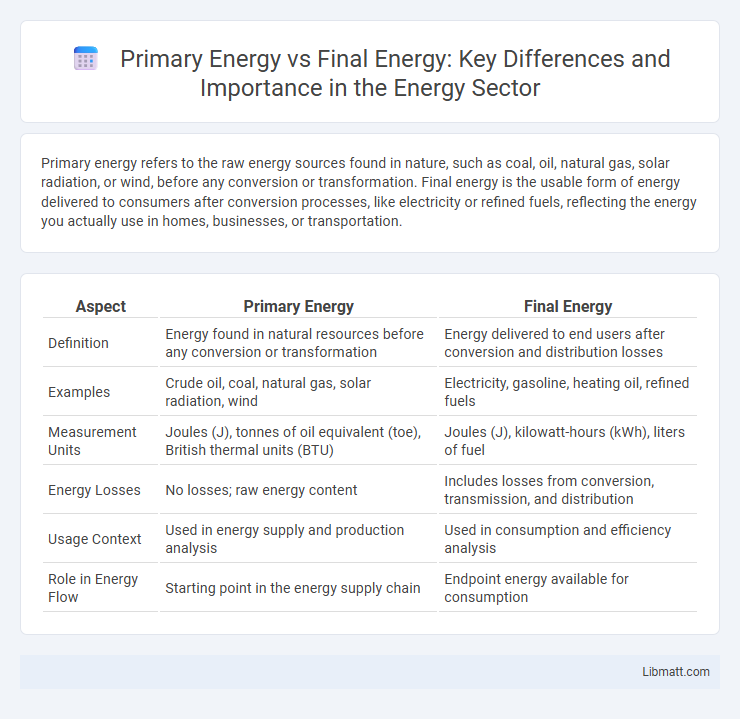Primary energy refers to the raw energy sources found in nature, such as coal, oil, natural gas, solar radiation, or wind, before any conversion or transformation. Final energy is the usable form of energy delivered to consumers after conversion processes, like electricity or refined fuels, reflecting the energy you actually use in homes, businesses, or transportation.
Table of Comparison
| Aspect | Primary Energy | Final Energy |
|---|---|---|
| Definition | Energy found in natural resources before any conversion or transformation | Energy delivered to end users after conversion and distribution losses |
| Examples | Crude oil, coal, natural gas, solar radiation, wind | Electricity, gasoline, heating oil, refined fuels |
| Measurement Units | Joules (J), tonnes of oil equivalent (toe), British thermal units (BTU) | Joules (J), kilowatt-hours (kWh), liters of fuel |
| Energy Losses | No losses; raw energy content | Includes losses from conversion, transmission, and distribution |
| Usage Context | Used in energy supply and production analysis | Used in consumption and efficiency analysis |
| Role in Energy Flow | Starting point in the energy supply chain | Endpoint energy available for consumption |
Understanding Primary Energy: Definition and Sources
Primary energy refers to energy found in natural resources before undergoing any conversion or transformation processes. Common sources of primary energy include fossil fuels such as coal, oil, and natural gas, as well as renewable resources like solar radiation, wind, hydropower, and biomass. Understanding primary energy is essential for analyzing energy supply chains and assessing environmental impacts associated with energy extraction and consumption.
What is Final Energy? Key Concepts Explained
Final energy refers to the energy delivered to end-users after conversion and transmission losses from primary energy sources such as coal, oil, or renewables. It represents the usable energy consumed in households, industries, and transportation for heating, electricity, and fuel purposes. Understanding final energy is crucial for evaluating energy efficiency, demand management, and designing sustainable energy policies.
Primary vs Final Energy: Core Differences
Primary energy refers to the raw energy sources extracted directly from nature, such as coal, crude oil, natural gas, solar radiation, and wind, while final energy is the usable energy delivered to end-users after conversion and transmission losses. Core differences include that primary energy involves raw, unprocessed fuels, whereas final energy represents the energy forms available for consumption like electricity, gasoline, or heat. Understanding this distinction is crucial for energy efficiency analysis, policy-making, and reducing environmental impacts throughout the energy supply chain.
The Energy Conversion Process: From Primary to Final
The energy conversion process transforms primary energy sources, such as coal, crude oil, natural gas, or renewable inputs like sunlight and wind, into final energy forms usable by consumers, including electricity, gasoline, and heat. This process involves multiple stages like extraction, transportation, refining, and electricity generation, each incurring energy losses that impact overall efficiency. Understanding the conversion from primary to final energy helps you optimize energy use and reduce waste in your consumption patterns.
Efficiency Losses in Energy Transformation
Primary energy refers to raw energy sources like coal, oil, natural gas, and renewable resources before any conversion, while final energy is the usable energy delivered to consumers after transformation processes. Efficiency losses in energy transformation occur during conversion from primary to final energy, typically resulting in significant reductions due to factors like thermal inefficiency and transmission losses. Understanding these losses helps you recognize the importance of improving energy conversion technologies to enhance overall energy efficiency and reduce environmental impact.
Examples of Primary and Final Energy in Daily Life
Primary energy sources include coal, crude oil, natural gas, sunlight, wind, and biomass, which are directly extracted from nature without any transformation. Final energy refers to the usable forms of energy delivered to consumers, such as electricity from power plants, gasoline for vehicles, and natural gas used for heating. In daily life, sunlight captured by solar panels represents primary energy, while the electricity powering household appliances is final energy.
Environmental Impacts: Primary vs Final Energy
Environmental impacts differ significantly between primary and final energy, as primary energy sources like coal, oil, and natural gas often involve higher greenhouse gas emissions and habitat disruption during extraction and processing. Final energy, used directly by consumers as electricity, heat, or fuel, reflects the efficiency of conversion and transmission, where losses contribute to additional resource consumption and emissions. Your energy choices and demand reduction can minimize environmental harm by favoring final energy with lower carbon footprints and higher efficiency.
The Role of Technology in Energy Efficiency
Technology plays a critical role in bridging the gap between primary energy and final energy by enhancing conversion and distribution efficiency. Advanced systems like smart grids, combined heat and power (CHP), and energy storage technologies reduce losses during energy transformation and delivery. Your energy consumption becomes more sustainable as these innovations optimize final energy use, minimizing reliance on inefficient extraction and conversion of primary energy sources.
Policy Implications: Managing Energy Flows
Primary energy refers to raw energy sources such as coal, oil, natural gas, and renewables, while final energy is the energy available for end-use after conversion and distribution losses. Effective energy policies must address the efficiency gap between primary and final energy to reduce environmental impact and resource depletion. Your decisions in managing energy flows can enhance system efficiency, promote sustainable development, and align with climate goals.
Future Trends: Optimizing Primary and Final Energy Usage
Future trends in energy management emphasize enhancing the efficiency of primary to final energy conversion through advanced technologies like smart grids and energy storage systems. Increasing the share of renewable primary energy sources, such as solar and wind, reduces losses associated with fossil fuel extraction and processing. Strategies including demand-side management and electrification of transport aim to optimize final energy consumption, minimizing overall environmental impact and improving energy security.
Primary energy vs Final energy Infographic

 libmatt.com
libmatt.com